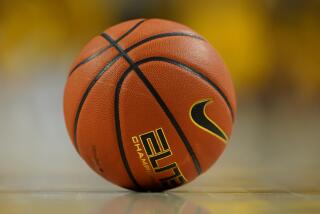Before Pastor Fred Price decided on a...
- Share via
Before Pastor Fred Price decided on a geodesic dome structure for his new 10,000-seat church, his Crenshaw Christian Center had already paid $400,000 in architectural and construction plans for an arena-like church with a balcony seating nearly half the congregation.
But a visit to Howard Hughes’ Spruce Goose in Long Beach prompted Price to inquire about the cost of putting his congregation under a similar roof and have everyone on the ground floor.
The “FaithDome,” the nation’s most spacious church with 10,145 seats, was the result. It was opened for regular services last Sunday in South-Central Los Angeles on what was once the Pepperdine University campus. The attendance was 8,116, church officials said.
Price’s church saved money because of his change of mind, he said, because the original construction price tag was much more than the $9 million spent on the FaithDome. Price had announced in June of 1982 that the octagonal, balconied church was going to cost $12 million to $13 million. Projected costs later climbed to nearly $18 million.
Richard Hedrick, the project’s developer, said dome construction produced a building that cost “less than $1,000 a seat.” (By contrast, the recently completed Lake Avenue Congregational Church in Pasadena, including more than just its 4,000-seat sanctuary, cost $20 million. The 3,000-seat Crystal Cathedral in Garden Grove also cost $20 million when it opened in 1980.)
The 320-foot-wide FaithDome rises about 65 feet above the rather plain, blue-carpeted center platform that serves as the pulpit area. The church-in-the-round has no supporting posts to obstruct the views of congregants, and the 32 doors to its sanctuary make entering and leaving easy. Air conditioning is fed through a mile of ducts into vents in the aisles.
The church says that the aluminum roof consists of 2,016 interlocking, 11-foot-by-11-foot triangles. It can withstand a magnitude 7 earthquake, according to the church fact sheet.
MEDIA
The independent Latter-Day Sentinel, a Mormon-oriented biweekly newspaper that avoided the stuffiness of official church pronouncements, has ceased to publish. The Southern California edition, which had about 10,000 subscribers, was edited by Carolyn Allen of Huntington Beach. She said she hopes that a similar publication will emerge eventually for Southland Mormons. The 10-year-old newspaper had 35,000 subscribers mainly in Arizona, California and Oregon. Publisher Larry Linton said, “We decided to go out of business for lack of advertising.”
Radio personality Carole Hemingway, who hosted the talk show “Religion on the Line” on KABC from 1974 to 1982, will launch a similar program on KGIL from 4 p.m. to 6 p.m. on Tuesdays, starting next week. She will use the same format--a Catholic priest, a Protestant minister and a rabbi fielding telephoned questions from listeners. Hemingway’s producer, Fred Harris, said Hemingway planned to use the same name, “Religion on the Line,” despite the fact that KABC kept the title for the talk show now hosted by Dennis Prager from 10 p.m. to midnight on Sundays. Prager, who was out of town, could not be reached for comment. But a KABC spokesman said he could foresee a problem if KGIL has an identically named program. It was unclear, however, what action, if any, KABC might take.
PEOPLE
Rabbi Naomi Levy will be formally installed Sunday evening as the first woman rabbi to lead a Conservative congregation on the West Coast. She will head the 75-year-old Temple Mishkon Tephilo in Venice, described by its officials as the oldest Jewish congregation on the Westside. A graduate of Cornell University and the Jewish Theological Seminary, Levy most recently served a temple in San Antonio.
CHANGE
Father Fisher Robinson, named the Los Angeles Archdiocese’s vicar for black Catholics in 1986, now calls himself the vicar for African American Catholics. He will host an open house at 2:30 p.m. Sunday for the new office of the African American Vicariate. “We’ve been phasing out the use of ‘black’ for the last several months,” said Tina Tomiyama of the archdiocese’s Ethnic Ministry Department. She said Robinson is using the term because of its growing popularity within the black community as a self-designation. The vicariate office, with representatives from about three dozen parishes, aims to aid the laity to evangelize and promote African American culture in the church. The new office is at 1530 W. 9th St., across the street from the chancery, or archdiocesan headquarters.
STATEMENT
The Southern California Board of Rabbis recently added its voice to that of U.S. Jewish leaders and many Catholic leaders, including Los Angeles Archbishop Roger M. Mahony, in urging the immediate removal of the Carmelite convent at the site of the World War II death camp at Auschwitz. “Auschwitz is a shrine, the silence of which is more profound than any prayers which could be offered there,” said the statement. The board has 250 rabbinical members from the Conservative, Orthodox, Reform and Reconstructionist branches of Judaism.
More to Read
Sign up for Essential California
The most important California stories and recommendations in your inbox every morning.
You may occasionally receive promotional content from the Los Angeles Times.









